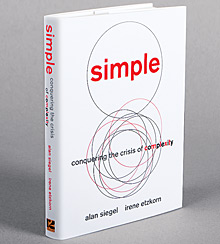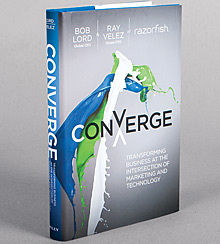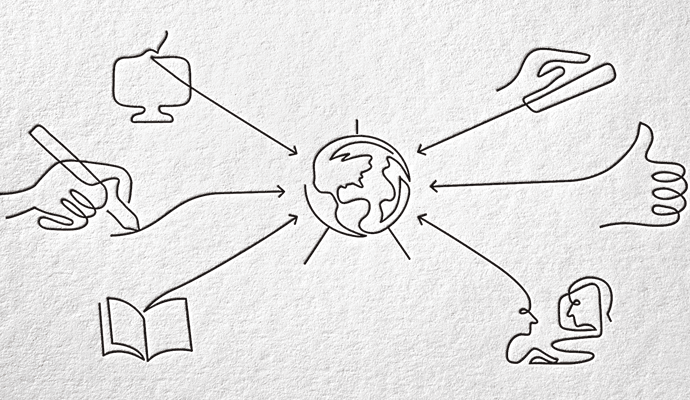Best Business Books 2013: Marketing
Is Your Brand Experienced?
(originally published by Booz & Company)
Alan Siegel and Irene Etzkorn
Simple: Conquering the Crisis of Complexity
(Twelve, 2013)
Jay Baer
Youtility: Why Smart Marketing Is about Help Not Hype
(Portfolio, 2013)
Bob Lord and Ray Velez
Converge: Transforming Business at the Intersection of Marketing and Technology
(Wiley, 2013)
Digital has been the big news in marketing for at least the last decade, but this year’s crop of marketing books suggest its newsworthiness has long ceased to “stop the presses,” to the extent that presses exist anymore. And it’s still not news even as mobile devices open up a whole new realm of possibilities for marketing and customer engagement.
I’m not saying that digital is over. Rather, we’ve reached that point in its evolution that TV must have hit sometime in the early 1960s: The power of the medium and its mechanics are well understood. Marketers don’t get excited anymore about the mere fact that Google or Facebook or behavioral targeting exists, nor do they wring their hands over how digital has enabled consumers to tune them out.
A real question—and a big one—is where do marketers go from here? For the authors of this year’s best business books on marketing, the answer is multifaceted but clear: Marketing increasingly concerns the customer experience, much of it digitally delivered. This point of view, if not completely post-marketing, is certainly post-advertising.
A brand like Amazon, for instance, may run some commercials on TV, but what really makes it sing are the tens of millions of satisfying and customized interactions that consumers have with the company each year, from its one-click shopping to its on-target recommendations. It’s also no coincidence that as marketing-as-experience has grown in importance, many of the earliest forms of digital marketing, in particular the banner ad, have been roundly discredited. They usually disrupt good experiences rather than create them.
Each of the best marketing books of 2013, in its own idiosyncratic way, successfully grapples with this sea change in how to create the positive consumer perceptions that ultimately build brands.
Keep It Simple
If marketing isn’t concerned solely with marketing anymore, it makes sense that the year’s best marketing book isn’t solely about marketing either. Instead, Simple: Conquering the Crisis of Complexity, by Alan Siegel and Irene Etzkorn, is something of a diatribe against the pervasive complexity that serves to frustrate consumers and undermine customer relationships.
At first, Simple struck me as over the top in its obsession with indecipherable phone bills and menus crammed with too many choices. Doesn’t society have bigger problems to address, such as climate change and cancer? But soon the realization dawned that complexity hasn’t jumped out at me as an urgent problem because I’ve become inured to it. I expect hidden gotchas in the reams of pages in credit card agreements that I will never actually read until it’s too late to avoid them, and I assume that the directions for assembling my new patio set will be so confusing that I will need to make multiple calls to the manufacturer’s helpline. Traditionally, we haven’t classified these annoyances as marketing problems—but as customer experience becomes a core element of marketing, it’s clear that the damage caused by complexity extends far beyond the customer service department.
Although Siegel and Etzkorn take on everything from the 14,000-page U.S. tax code to prescription drug labels, rest assured their book is written from a marketer’s point of view: Siegel previously founded and led the global branding agency Siegel + Gale and now leads Siegelvision, an organizational identity and brand strategy consultancy; Etzkorn is Siegelvision’s chief clarity strategist.
“Customers are fed up with bureaucracies that inundate us with generic and impersonal information, don’t take our calls, create convoluted procedures, request too many signatures, provide baffling instructions, erect barriers of legalese, and find a thousand other ways to distance themselves from us,” declare the authors. “The truth is, every bit of correspondence you send to customers—email correspondence, statements, contracts, proposals, instructions, applications, call center scripts—speaks louder than your ads, because it’s a more direct and personal form of contact.” In short, if your cheeky ads are followed up with an awful website experience or a contract dripping with legalese, you’ve blown it.
For those who remain unconvinced that simplicity is better business, the authors give anecdotal evidence of the overlap between companies that simplify and those that go on to achieve runaway success. Unsurprisingly, Apple and Google play a prominent role in Simple, as do Trader Joe’s (which offers about one-tenth of the products of a typical supermarket) and, in one of the book’s best examples, Southwest Airlines.
The Southwest story is so powerful because it demonstrates that it’s possible to simplify even in excessively complicated categories. When the airline was launched 45 years ago, its founders sought simplicity by buying only Boeing 737s, eschewing the intricate hub-and-spoke system for nonstop flights, and forgoing assigned seats. The upstart airline passed the benefits of simplicity on to consumers in the form of lower fares and fewer extra fees. (In a category that increasingly nickels-and-dimes its customers, Southwest still checks the first two bags free.) The Southwest story underscores the fact that Simple is not going to let you off the hook, even if you argue that simplicity won’t work in your company.
As you might expect, Simple devotes a good deal of time to the jargon masters who dwell at the very top of the complexity food chain: lawyers. Siegel and Etzkorn argue that the greatest fear of the typical CEO is lawsuits, and that fear has served to “elevate lawyers to a position of unchallenged authority.” They argue that plain language “can actually end up putting you on safer legal ground, because it provides plain evidence that you were never trying to hide anything or hoodwink anyone.”
The legal department’s very existence points to the most difficult thing about becoming simple: adopting the approach across the organization. Any company can whittle down its contracts, but achieving true simplicity, like every other major change initiative, requires buy-in and support from the top. It takes vision to infuse an organization with a more simplified approach, which in its highest form affects the way a business operates, how it markets itself, and how it creates great customer experiences. Thus, the first step toward better marketing may be getting a copy of Simple to the CEO.
How Can I Help You?
Like Siegel and Etzkorn, Jay Baer, president of Convince & Convert, a social media and content marketing consultancy, has little regard for traditional marketing and the quest for awareness, particularly as mass media continues its decline. “Whether it relies on old media or new,” writes Baer in Youtility: Why Smart Marketing Is about Help Not Hype, “top-of-mind awareness is less effective than ever as a marketing strategy for two reasons: You can’t promote to people you can’t find, and distrust of business erodes its foundation.”
Instead, Baer thinks that marketers should be delivering marketing that is “truly, inherently useful” to its intended audiences—marketing that has, as his would-be catchphrase puts it, youtility. Examples of youtility include Procter & Gamble’s Charmin Sit or Squat app, which features Yelp-like reviews of public bathrooms; Scotts Miracle-Gro newsletters, which offer customized advice on lawn care based on where readers live and the type of lawn they have; and the Holiday World amusement park website, which posts every detail a roller coaster fanatic could want about each of its coasters, including track length, top speed, and the height of the lift hill.
Although I wouldn’t classify these examples as earthshaking, they are worth considering in light of the real-world underpinnings of Baer’s argument. First, as marketers try to employ social media, they are competing for attention against the very people they are courting. Thus, says Baer, “your prospective customers must consider you to be a friend. And if, like their friends, you provide them real value, if you practice youtility rather than simply offer a series of coupons and come-ons, they will reward your company with loyalty and advocacy, the same ways we reward our friends.” You-tility is not getting customers to like your Facebook page; it is using that and other platforms to be helpful to them.
Second, the consumer penchant for doing research before buying has increased exponentially in the Digital Age. Baer cites a 2010 Google study that found that people referred to 5.3 information sources before a purchase decision; a year later, they referred to 10.4 sources.
This yen for information isn’t limited to big-ticket purchases. These days, people tap 5.8 sources of information before deciding which quick-serve restaurant to go to. “If the fact that Americans need almost six data inputs before pulling the trigger on a chicken sandwich decision doesn’t convince you of the need to win the war of information, I give up,” writes Baer.
He argues that these days, the key to a marketer’s success is becoming part of that pool of information sources. Witness the Clorox myStain mobile app, which offers stain-fighting advice on the fly. A great way to market Clorox’s products? Sure, but a crucial part of the app’s success is the company’s willingness to help even when that help doesn’t include its products.
As the book makes clear, the array of tools in the youtility toolbox is vast. Baer draws not just on CPG brands, but also on hospitals, hotels, and even taxicab drivers, one of whom publishes a newsletter, “Taxi Mike’s Dining Guide: Where to Eat in Banff.” Distributed free all over town, the guide has nothing to do with cab rides, but who are you going to call for a ride back to your hotel after you’ve had a great meal at a restaurant recommended by Taxi Mike?
We’ve heard the youtility thesis before, but it says something about the timing of this book and its practical, universally applicable advice that as I write this, it is on the New York Times hardcover bestseller list.
Delivering Experience
If experience is becoming the essence of marketing, experience delivery is becoming a more high-tech endeavor. These days, marketers must also be technologists.
Converge: Transforming Business at the Intersection of Marketing and Technology dives deep into the ramifications of technology-infused marketing. Written by ex-CEO Bob Lord and CTO Ray Velez of the digital marketing agency Razorfish (for which I have worked), the book covers topics including data-driven experiences, the cloud, open source software framework Hadoop, and agile methodology (an innovative, iteration-based software development practice) with a facility that can boggle the reader’s mind. And if you don’t know what words such as ubicomp mean, be prepared to use the glossary. But then, if you don’t know that ubicomp means ubiquitous computing, it’s all the more reason to read this clear-eyed, comprehensive look at how technology is changing customer experience.
As you read it, pay particular attention to how Lord and Velez position the volume of technology in the marketing universe. “Winners in the twenty-first century won’t be distinguished by how fast they master buzzwords or how many faddish new digital marketing campaigns they undertake,” the authors write. “Those winners will be organizations whose main focus is on their consumer’s journey and who possess a relentless desire to understand and improve that journey from beginning to end. This isn’t merely about serving up new ads cloaked in the latest social fashion, but about improving the consumer experience at all stages.” Yes, there’s the e-word again.
Converge is one of the few marketing books that deal with the back end of customer experience—with how to use technology to deliver it. You may wonder what cloud computing and agile methodology have to do with marketing. But both are fitting metaphors for the real-time nature of marketing. As Lord and Velez write in a brief section on the hoary TV upfronts, in which marketers vie to buy commercials up to a year in advance, “For those individuals who spend most of their marketing budget in digital channels, the upfront is a striking outlier from the rest of marketing reality. Marketing in the twenty-first century is all about speed, accountability, data, and digital. The upfronts are about long-term thinking, guesstimations on the potential success of new programming, personalities, and, of course, golf.”
What cloud computing and agile methodology have in common is that they can play a crucial role in making marketing a continuously iterative process, and rescuing it from its traditional guise as a long-lead-time, big-budget ocean liner that is difficult to turn when the waters ahead get choppy or a better course reveals itself.
The cloud takes infrastructure concerns off the marketer’s plate. “You need to think of data centers not as something you build but as something…you rent to keep your costs down, to improve speed to market, and to allow your people to focus on innovation,” explain the authors.
Agile methodology, which grew out of the application of lean production principles to software development, concerns how people work. “An agile marketing organization,” say the authors, “is always on and responsive and is not driven by campaigns locked in a year ahead of time.” During a project for Ford, for example, Razorfish began by focusing its efforts on features that helped Ford’s customers manage high gas prices. But when gas prices declined in the middle of the project, an agile work method enabled the team to shift its focus to other, more germane car-buying concerns, like financing.
Even as many marketers have looked to create real-time advertising, such as Oreo’s “You Can Still Dunk in the Dark” tweet during 2013’s Super Bowl blackout, the use of technology as a means of creating real-time experiences that tap into consumer wants and needs holds much greater promise. If that’s not fundamental to effective marketing, then what is?
Considering the sheer magnitude of ad budgets, the vast majority of the interactions most of us have with brands are still going to be through advertising. The problem is, as this year’s best business books on marketing make clear, the vast majority of those interactions will not enable or encourage consumer interaction with the brands that they purport to be building. Taglines be damned, it’s time to address how customers experience your brand.![]()
Author profile:
- Catharine P. Taylor has covered digital media since 1994, writing for publications including Adweek and Advertising Age. She currently writes a weekly column for MediaPost, and is a frequent speaker on social media’s impact on advertising, media, and behavior.






